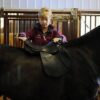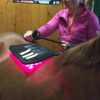What is Acupressure?
Acupressure is an ancient healing art that uses the fingers to press key points on the surface of the skin to stimulate the body’s natural self-curative abilities. When these points are pressed, they release muscular tension and promote the circulation of blood and the body’s natural force to aid healing. Acupuncture and acupressure use same points, but acupuncture employs needles, while acupressure uses a gentle but firm pressure of the hands (and even feet). There is a massive of the amount of scientific data that demonstrates why and how acupuncture is effective. But acupressure, the older of the two traditions, was neglected after the Chinese developed more technological methods for stimulating points with needles and electricity. Acupressure, however, continues to be the most effective method for self treatment of tension related ailments by using the power and sensitivity of the human hand.
Foremost among the advantages of acupressure’s healing touch is that it is safe to do on yourself and others—even if you’ve never done it before—so long as you follow the instructions an’d4pay attention to the cautions. There arc no side effects from because there are no drugs. And the only equipment needed are your own two hands. You can practice acupressure therapy anytime, anywhere.
My clinical experiences over the past 18 years have shown me that acupressure can be effective in helping relieve headaches, eyestrain, sinus problems, neck pain, back aches, arthritis, muscle aches, and tension due to stress. I have also shown hundreds of my .acupressure students, patients, and friends how to use acupressure to relieve ulcer pain, menstrual cramps, lower back aches, constipation, and indigestion. You can also use self acupressure to relieve anxiety and to help you go to sleep at night.
Susan, as student of mind, was suffering from insomnia and occasional headaches for many years, as the result of a neck injury. 01 feel so tired and weary, nearly all of time, Michael,” she said. “Can acupressure points help me?” I showed her several potent points on her ankles and neck for headaches, as well as some upper back stretching exercises for her insomnia. Susan reported to me two weeks later, glowing. The treatment really worked! I’ve been sleeping uninterrupted and soundly throughout the night for the first time in 15 years.
There are also great advantages to using acupressure as a way to balance the body and maintain good health. That healing touch of acupressure reduces tension, increases circulation, and enables the body to relax deeply. By relieving stress, acupressure strengthens resistance to disease and promotes wellness.
In acupressure, local symptoms are considered an expression of the condition of the body as a whole. A tension headache for instance, maybe rooted in the shoulder and neck area. Thus acupressure focuses on relieving pain and discomfort as well as on responding to tension before it develops into a “disease”, that is, before the constrictions and imbalances can do further damage. By using a combination of self-help methods such as trigger point stimulation, deep breathing, range of motion exercises, and relaxation techniques, you can improve your condition as well as feel more alive, healthy and in harmony with your life.
Recently, Judy, one of my advanced acupressure students, complained about having night sweats. She was in the midst of making a serious decision about where to live, which also involved a relationship that was troubling her. I immediately noticed that her upper hack was rounded by tension and discovered even more tension in her neck. I showed her the points for working on these areas. A month later, after using acupressure on herself twice a day, Judy reported that much of her upper back tension and a ball of deep anxiety had dissipated. She also felt clearer and more objective in dealing with her problems. Best of all, the night sweats that had made her miserable for two months were gone.
Alice, one of my elderly clients, had limited mobility in her neck with severe arthritic pain that radiated down her shoulders into her anus as well as up into her hand. After her first acupressure session, she not only felt less discomfort hut also had greater flexibility in her neck. For the first time in years, site was able to move her head freely without pain.
After several weeks Alice realized that she could help herself using the points underneath the base of her skull to relieve both her neck pain and stiffness. Recently she told me that whenever the pain “creeps up on her,” site practices self-acupressure. It is possible that this increased mobility, in turn, prevents further deterioration.
The development of acupressure
The origins of acupressure are as ancient as the instinctive impulse to hold your forehead or temples when you have a headache. Everyone at one time or another has used his or her hands spontaneously to hold tense or painful places on the body.
More than 5000 years ago, the Chinese discovered that pressing certain points on the body relieved pain where it occurred and also benefited other parts of the body more remote from the pain and pressure point. Gradually, they found other locations that not only alleviated pain but also influenced the functioning of certain standard internal organs.
In the early Chinese dynasties, when stones and arrows were the only implements of war, many soldiers wounded on the battlefield reported that symptoms of disease that had plagued them for years had suddenly vanished. Naturally, such strange occurrences baffled the physicians who could find no logical relationship between the trauma and the ensuing recovery of health. After years of meticulous observation, ancient Chinese physicians developed ways of curing certain illnesses by striking or piercing specific points on the surface ‘of the body.
As with the Chinese soldiers, people through the ages have found the most effective ways to help themselves by trial and error. The art and science of acupressure was practiced by the contributions of people whose awareness was so highly developed that they could feel where the bodies of people in pain were constricted and sense which trigger points would alleviate the problem. The Chinese have practiced self-acupressure for over 5,000 years as a way of keeping themselves well and happy. You, too, can learn how to complement the care you receive from your doctors. You can help your body relieve itself of common ailments, such as those in this book, by pressing the proper spots, which I will teach you. In the course of trying out these points, you may even find others that work better for you.
Many of the health problems in our society bad backs to arthritis’—are the result of living unnaturally. Stress, tension, lack of exercise, poor eating habits, and poor posture contribute to the epidemic of degenerative diseases in our culture. Acupressure is one way to help your body fight back and balance itself in the face of the pressures of modern life.
How Acupressure Works
Acupressure points (also called potent points) are places on the skin that are especially sensitive to bioelectrical impulses in the body and conduct those impulses readily. Traditionally, Asian cultures conceived of the points as junctures of special pathways that carried the human energy that the Chinese call chi and the Japanese call ki. Western scientists have also mapped out and proven the existence of this system of body points by using sensitive electrical devices.
Stimulating these points with pressure, needles, or heat triggers the release of endorphins, which are the neurochemicals that relieve pain. As a result, pain is blocked and the flow of blood and oxygen to the affected area is increased. This causes the muscles to relax and promotes healing. Because acupressure inhibits the pain signals sent to the brain through a mild, fairly painless stimulation, it has been described as closing the “gates’ of the pain system, preventing painful sensations from passing through the spinal cord to the brain.
Besides relieving pain, acupressure can help rebalance the body by dissolving tensions and stresses that keep it from functioning smoothly and that inhibit the immune system. Acupressure enables the body to adapt to environmental changes and resist illness.
Tension tends to concentrate around acupressure points. When a muscle is chronically tense or in spasm, the muscle fibers contract due to the secretion of lactic acid caused by fatigue, trauma, stress, chemical imbalances, or poor circulation. For instance, when you are under a great deal of stress you may find you have difficulty breathing. Certain acupressure points relieve chest tension and enable you to breathe deeply.
As a point is pressed, the muscle tension yields to the finger pressure, enabling the fibers to elongate and relax, blood to flow freely, and toxins to be released and eliminated. Increased circulation also brings more oxygen and other nutrients to affected areas. This increases the body’s resistance to illness and promotes a longer, healthier, more vital life. When the blood and bioelectrical energy circulate properly, we have a greater sense of harmony, health, and wellbeing.
Acupressure Massage Techniques
We’ll use the following techniques in the exercises throughout the book.
— Caution:If you have a serious illness or chronic or life-threatening illness such as heart disease, cancer, or high blood pressure, you should not use the following techniques described in these exercises: Brisk rubbing, deep pressure, kneading, or other recommendations that may be over stimulating



